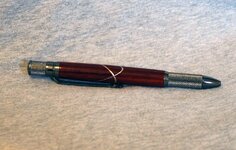Ingo Schwartz
Member
Hi guys.
I'm on a sick leave from work for the next 3 weeks and I want to take the time and make a few blanks using a scroll saw (I can sit down while doing it and no heavy lifting required!) but I'm a bit short on CA glue and getting more is not really an option. Using RJB Woodturner's method of segmenting soda cans with wood, could I use epoxy to do it ?
I know the time taken for each side will be considerably more using Epoxy but I have loads of that stuff and I can make more blanks at once giving each glue-up a few hours before starting a new cut.
Could I color the epoxy to give a different look or would it just squeeze out ?
I'd be very greatful for any advice given.
Thanks in advance
Ingo
I'm on a sick leave from work for the next 3 weeks and I want to take the time and make a few blanks using a scroll saw (I can sit down while doing it and no heavy lifting required!) but I'm a bit short on CA glue and getting more is not really an option. Using RJB Woodturner's method of segmenting soda cans with wood, could I use epoxy to do it ?
I know the time taken for each side will be considerably more using Epoxy but I have loads of that stuff and I can make more blanks at once giving each glue-up a few hours before starting a new cut.
Could I color the epoxy to give a different look or would it just squeeze out ?
I'd be very greatful for any advice given.
Thanks in advance
Ingo

![1915651_500428126807266_8879804534953128027_n[2].jpg 1915651_500428126807266_8879804534953128027_n[2].jpg](https://www.penturners.org/data/attachments/129/129489-9ad3ff2dfd573123e51b3bf37eedd379.jpg?hash=mtP_Lf1XMS)
